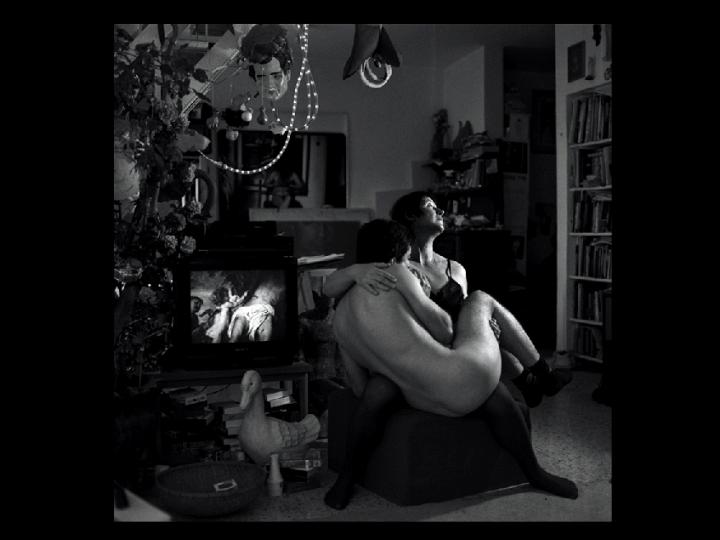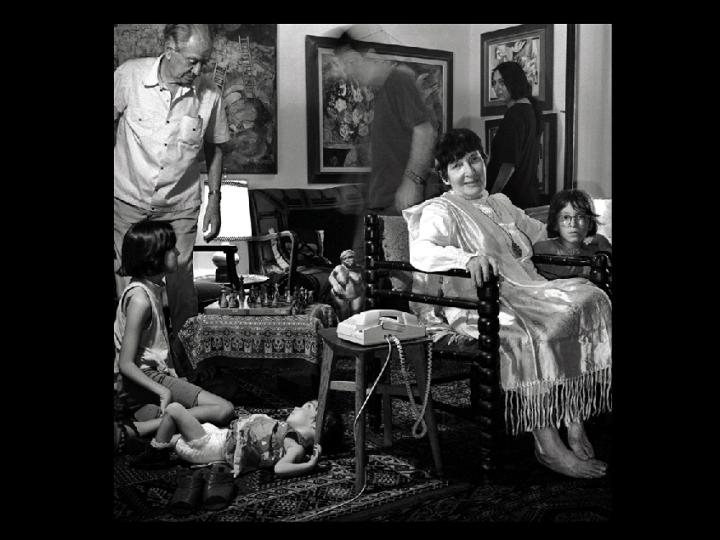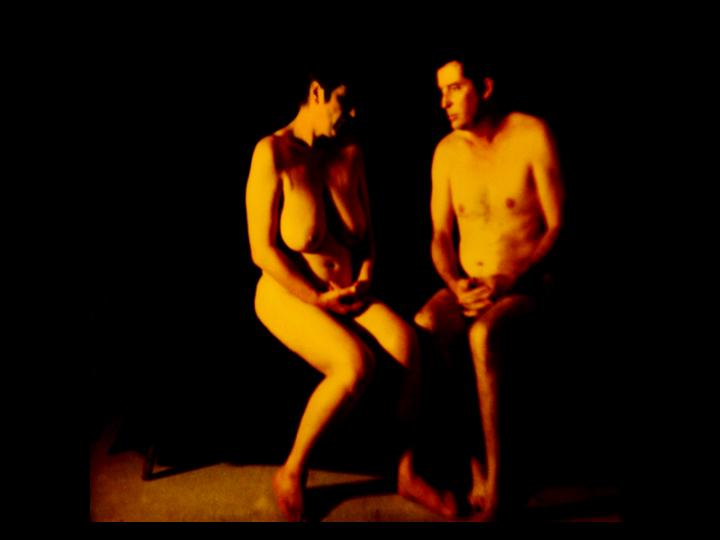
|
|
|
 |
|
 |
|
|
 |
|
|
|
|
|
|
|
|
|
|
"Boaz Tal:
Allegory/Allegro (Non Troppo)" (2001)
by A. D. Coleman
|
|
|
The trouble with living in a country whose inhabitants reckon time according to three different calendars that set their starting dates variously within a 4400-year stretch of historical time is that you never know what epoch you're inhabiting. One person's run-of-the-mill year is another's millennium; this one awaits spring rain, that one a messiah, or Armageddon.
 So, depending on your specific faith (or secularized acceptance of prevailing social convention in your community), these works from 1988 A. D. through the present by Boaz Tal were created in the last decades of the second millennium (according to the Christians), between 5748 and 5761 (on the Hebrew calendar), or in the years 1366-79 (for the Muslims). Small wonder that he, and we, and they all seem so confused, lost in a desert of overlapping time frames, stopping for solace at the oases of this or that mythology -- only to push on again as chrononomads must, compulsively, in search of that moment and locale in which the clocks all chime in tandem. Best bring a lunch. So, depending on your specific faith (or secularized acceptance of prevailing social convention in your community), these works from 1988 A. D. through the present by Boaz Tal were created in the last decades of the second millennium (according to the Christians), between 5748 and 5761 (on the Hebrew calendar), or in the years 1366-79 (for the Muslims). Small wonder that he, and we, and they all seem so confused, lost in a desert of overlapping time frames, stopping for solace at the oases of this or that mythology -- only to push on again as chrononomads must, compulsively, in search of that moment and locale in which the clocks all chime in tandem. Best bring a lunch.
Enter, then, this mirage he's constructed for you. It's only an illusion, of course, just light waves rippling through your optic system and into your parched mind, and you know it. But give yourself over to it anyway . . .
Engage with any of these photographs and you find yourself in two and frequently three places simultaneously. First, of course, you are "here," meaning wherever it is that you're standing or sitting while viewing that particular picture, perhaps on a wall of the Tel Aviv Museum of Art, perhaps somewhere else -- in a gallery in Montreal or New York, for example, since Tal's work travels widely on an international circuit; and of course you may be looking at it reproduced in the pages of this very catalogue. At the same time, you are "there," vicariously present behind the camera at the moment the exposure was made and the scene encoded on film. Finally, in many cases, you are imaginatively somewhere else again -- in the historic or mythic moment depicted, whether that's the Annunciation, the Judgment of Paris, or the rude, gritty dinner of Van Gogh's "Potato Eaters." Where, exactly, does that leave you?
Photographs manifest a curious relationship to the anachronistic. Because they encode and represent the specific moments of their making, they give the lie to themselves blatantly whenever they're used to depict events that took place before photography's invention, or before the distinctive tools of a particular photographic process became available.1 Despite the purported photographic portrait of Jesus supposedly made with a camera obscura circa 30 A.D. and recently "discovered" by anthropologist Dr. Bradley Durbin,2 stylized and self-evidently fictive photographic renderings of historic events or mythological scenes affect us quite differently than do comparable representations in the traditional visual media.
 This happens because we know -- intellectually, of course, but also on a certain kinaesthetic level -- that the person we're looking at isn't Napoleon or Joan of Arc or George Washington but actually a hired model or the janitor or even the photographer him- or herself, and our attention goes not only to the photographer's inventiveness and to the quality of that person's disguise and impersonation but also to his or her presence in the situation and inner life in that instant before the lens. Who, looking at a painting of the Crucifixion known to have been done from a tableau set up in the studio, would ask, "Why is that woman Mantegna painted pretending to be Mary Magdalen? What's going on in her head as she poses?" And who, looking at a photographic version of the same scene, would not? This happens because we know -- intellectually, of course, but also on a certain kinaesthetic level -- that the person we're looking at isn't Napoleon or Joan of Arc or George Washington but actually a hired model or the janitor or even the photographer him- or herself, and our attention goes not only to the photographer's inventiveness and to the quality of that person's disguise and impersonation but also to his or her presence in the situation and inner life in that instant before the lens. Who, looking at a painting of the Crucifixion known to have been done from a tableau set up in the studio, would ask, "Why is that woman Mantegna painted pretending to be Mary Magdalen? What's going on in her head as she poses?" And who, looking at a photographic version of the same scene, would not?
I should also point out that it would probably prove less disconcerting to have these images presented to us in a book, or as standard-sized photographic prints, portable and nicely contained between covers or in small metal sectional frames. Photographs use many rhetorical devices to make their arguments, and one of those devices is scale: first the scale of things as organized within the frame of the image, and then the scale of the photographic object itself. Today, with large monochrome and color prints both technically and economically feasible, and exhibition spaces accustomed to displaying them, photographs -- which not too long ago rarely took a physical form bigger than the average drawing or engraving -- often come to us looming as large as once only paintings and sculptures could. And that transforms our relationship to them dramatically. What formerly we had to stand close to and peer into now engulfs us, even from a distance. Bringing the human figure up to life-size and larger, as Tal does here, has a deep and immediate psychological effect on the viewer. So too does the fact that more than a few of these figures make eye contact with the spectator -- reversing the gaze, as it were, in a manner as startling as suddenly meeting the eyes of some stranger in a crowd.
In effect, Tal has created here an installation populated with lifelike simulacra of human beings, which mimics and gently parodies familiar, culturally loaded scenarios while simultaneously limning a private, familial landscape that constitutes a minefield of sorts. Wife, husband, children, mother, father, brother, sister . . . these configure exactly the dangerous terrain that so many of us traverse nowadays as a quotidian given, a social yet personal psychic space that from its ancient origins through the immediate present has proven emotionally explosive and surely fraught with peril, the private sphere no less chancy than the public. From the pictorial evidence, Tal views the risks and sacrifices involved in the delicate work of intimate kinship with wry humor, patience, affection, acceptance, and a degree of resignation.
If we treat this as a domestic chronicle -- and on one level at least it is such, an exaggerated family album, all those depicted being the artist's immediate relatives (plus one ex-spouse) -- it proposes that all the mighty stories from our sacred texts and ancient legends find themselves inscribed again and again in the everyday lives we live with others. Writ small, perhaps, but there for the reading nonetheless. Meanwhile, on another level, it suggests that those astonishing, transcendent lives of the saints and martyrs, those extravagant sagas of legendary heroes and villains, constitute nothing more than our own endless, mundane travails writ large.
One can take these parables either way. Tal might choose to have us read "Playing chess with my father" as a reference to Ingmar Bergman's The Seventh Seal, a symbolic duel with Death itself; yet it may prove more resonant in its blunt suggestion that father-son relations can manifest the complexity, competitiveness, and ruthlessness of chess, in whose m ortal combat all concern for other relationships can become subsumed. "The Adoration of the Child" (subtitled "Self-Portrait with My Family") may suggest that within us each there resides something sacred that merits reverence, but at the same time it hints that emotionally we each -- regardless of age -- carry our childhood within us, and that a family of two adults and three offspring is always, on some level, a family of five children, all needing to be adored, all in search of love. The two "After the Fall" sections take their cue from the fable of the expulsion from paradise, but resonate with failings and anguishes less monumental than breaching the command of God though no less piercing -- the lies and betrayals and guilts and punishments of our quotidian relationships that weave through the textures of our lives. ortal combat all concern for other relationships can become subsumed. "The Adoration of the Child" (subtitled "Self-Portrait with My Family") may suggest that within us each there resides something sacred that merits reverence, but at the same time it hints that emotionally we each -- regardless of age -- carry our childhood within us, and that a family of two adults and three offspring is always, on some level, a family of five children, all needing to be adored, all in search of love. The two "After the Fall" sections take their cue from the fable of the expulsion from paradise, but resonate with failings and anguishes less monumental than breaching the command of God though no less piercing -- the lies and betrayals and guilts and punishments of our quotidian relationships that weave through the textures of our lives.
So here you will find suffering, penitence, lust, loss, shame, all the other major and minor tropes of our tumble from a state of grace, sins of omission and commission, the mortal ones and the mere peccadilloes, evoked with a mix of melancholy and irony, presented as monumental in scale yet commonplace as a weekday supper or an afternoon at home. We are what we are, flaws and all, it seems, and must learn to make the best of it. Tal tells me that he thought of titling this exhibition either "Allegro Non Troppo" (a musical term describing a tempo that's happy, but not too much so) or else "'Allegory of Time and Life" (after the painting by Bronzino). This seems an appropriate sliding scale along which to measure this work in this moment, the first year of the millennium for some but not for others, when prudence recommends that we take our joy with caution until we find some way to agree at least on what day it is, if it's even day at last.
-- A. D. Coleman
Staten Island, New York
June 2001
1 And, conversely, photographs read no less strangely when that situation's reversed -- as when, for example, a present-day daguerreotypist like Jerry Spagnoli makes an image of the Empire State Building, using a technology that went out of fashion in the mid-nineteenth century to describe a Depression-era skyscraper at the end of the twentieth.
2 See Randy Jeffries, "Ancient Photo of Jesus Found! Primitive 'camera obscura' captured Christ's image in 30 A.D.," in the Weekly World News, Vol. 21, no. 7 (Nov. 9, 1999), pp. 24-25.
This essay originally appeared in the exhibition catalogue Boaz Tal: Allegory/Allegro Non Troppo: Works 1978-2001, edited by Nili Goren (Tel Aviv: Tel Aviv Museum of Art, 2001). © Copyright 2001 by A. D. Coleman. All rights reserved. For reprint permissions contact Image/World Syndication Services, POB 040078, Staten Island, NY 10304-0002 USA;T/F (718) 447-3091, imageworld@nearbycafe.com.
|
|
|
|
|
|
|
|
|
|
|
|
|
|
|
|
|
|
|
|
|
|
Back to top
All contents © copyright 2003-05
by A. D. Coleman/PCCA
and the authors and artists, except as indicated.
All rights reserved.
info@photocriticism.com
Site design by John Alley
|
|
|
|
|
|
|
|
|
|